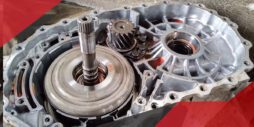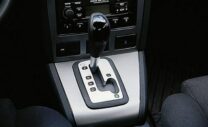
Automatic transmission kicks: the reasons why the machine twitches
Content
Sometimes the automatic transmission does not function correctly. Such malfunctions in her work often manifest themselves through the formation of a kind of kicks. Many motorists often have to face similar problems. Some people start to panic, do not know what to do. But you should not panic, because it is important to first understand the reasons. Some are minor and easy to fix.
Automatic transmission kicks for reasons
There can be many reasons. The gearbox consists of a large number of components, some of which may fail or be damaged. One of the most common causes is jolts in Drive mode. There are several main reasons why this problem appears. Sometimes it is enough to timely replace the lubricant inside the transmission.

Therefore, if characteristic kicks have begun, you just need to check the condition of the oil inside the box. But it is not always possible to get rid of jolts after changing the oil and filter components. A complete diagnosis may be required to identify the underlying causes. Thanks to her, most often it is possible to identify all the problems associated with the problematic functioning of the box.
A very common problem is also a problem with the torque converter or valve body. If the exact cause of the problem is established, it is necessary to replace the solenoids or make a complete replacement of the entire unit. Problems of this type most often appear in vehicles with a mileage of more than 150 thousand kilometers. They also occur in the absence of a timely oil change. To organize high-quality prevention of kicks, it is necessary to change the oil in the box in a timely manner. It is necessary to take into account all the requirements that the manufacturer makes.
Why does the machine kick on cold or hot?
Owners of cars with an automatic transmission are often forced to face such jolts. Jerking cold or hot can occur for the following common reasons:
- Insufficient amount of lubricant inside the box.
- Poor quality level of oil used for lubrication.
- Problems with the functioning of the hydraulic transformer. If the interlock stops working properly, jolts appear.

To resolve this problem, you can take several simple steps, among which are:
- Optimization of the oil level in the box. You just need to add the right amount of grease.
- Complete replacement of the used transmission oil.
- Complete gearbox diagnostics.
Why does the machine jerk when switching?
Vehicle jerking often occurs during shifting. If a hot engine starts to jolt when shifting or using drive mode, the hydraulic plates need to be repaired. It is because of them that problems often arise. It must be understood that this work is quite complex, time-consuming and expensive.
If kicks occur during braking, this indicates problems with the operation of the hydraulic unit and clutches. In this case, the problem is resolved only through the removal of the box and its complete disassembly. It is imperative to replace damaged mechanical elements, clutches. It should be understood that solenoids have a limited service life. Most often, they can work up to hundreds of thousands of kilometers. After that, a replacement will definitely be required. If shocks occur, it is advisable to carry out diagnostics to identify the causes as accurately as possible.

Sometimes jolts appear when reverse gear is engaged. This indicates a problem with the sensor, hydraulic transformer. These transmission components can be damaged. To accurately determine the problem node, computer diagnostics are required. Shocks in this case can occur due to incorrect operation of sensors, the absence of a normal level of warming up of the car. Therefore, you just need to check the sensor, warm up the car.
Shocks during shifting may not necessarily be due to direct breakage within the box itself. Often, such problems arise due to elementary circumstances, which can be eliminated without problems. However, not every car owner knows about this. Common reasons include:
- Insufficiently high heating of transmission elements. They just have a temperature that is too low to function properly, which causes tremors.
- Old oil or fluid of frankly poor quality.
- Too little gear oil.
Solving problems is easy. You just need to:
- It is normal to warm up the car and its box to the optimal temperature at which the functioning will be adequate.
- Add the correct amount of oil to the required level.
- Replace the lubricant. It is important to follow the recommendations of the car manufacturer, use oil from a trusted manufacturer that meets the established standards.
When shifting from first gear to third, characteristic kicks may occur. This is most often due to wear on some of the working components of the transmission. The same can happen when shifting from second to third gear. Shocks can occur due to low-quality oil, its overheating. But in any case, the best way out of this situation would be to contact a specialized service, whose employees, with the help of special equipment, will perform diagnostic work. Usually they allow you to identify all the hidden causes of kicks and similar problems, to correctly eliminate them.
Why does the automatic transmission kick when shifting into gear?
If such a problem occurs, you need to check if the machine is warmed up well. After that, you need to assess the oil level in the box. An important nuance is the time of the last fluid change. If one of these factors occurs, tremors become possible. It is also advisable to store the car in appropriate conditions so that it does not overcool. This is a very simple preventive measure.
Warming up the vehicle is a necessary process. Failure to warm up the engine will cause problems. The oil becomes thicker at low temperatures, which traps small particles from the bottom of the compartment. They settle on the elements of the box, reduce the level of the chain, and make contact difficult. When the oil warms up, all unnecessary is washed off the gears, normal functioning is guaranteed.
Software problems
Jolts of the automatic gearbox can occur during braking due to problems with the software that controls the system. This problem can be resolved only by reinstalling the control automation. It is imperative to update the firmware. This work can be done with new boxes, which also allows you to optimize their work, and not just eliminate kicks. Re-flashing is carried out in the service centers of specific manufacturers. The solution to the problem is made after diagnostics and identification of specific problems.
Video: why the automatic box twitches
Questions and answers:
What to do if automatic transmission kicks? In this case, in the absence of experience in the repair of such units, it is necessary to contact a car service to diagnose and eliminate the cause of this effect.
How do you know that the automatic transmission is kicking? In D mode, the brake pedal is released and the accelerator pedal is gently depressed. The machine should pick up speed smoothly without harsh gear changes and jerks.
Why does the automatic transmission kick in cold weather? This is primarily due to the low oil level in the transmission. It can also happen when the oil has not changed for too long (has lost its lubricating properties).

